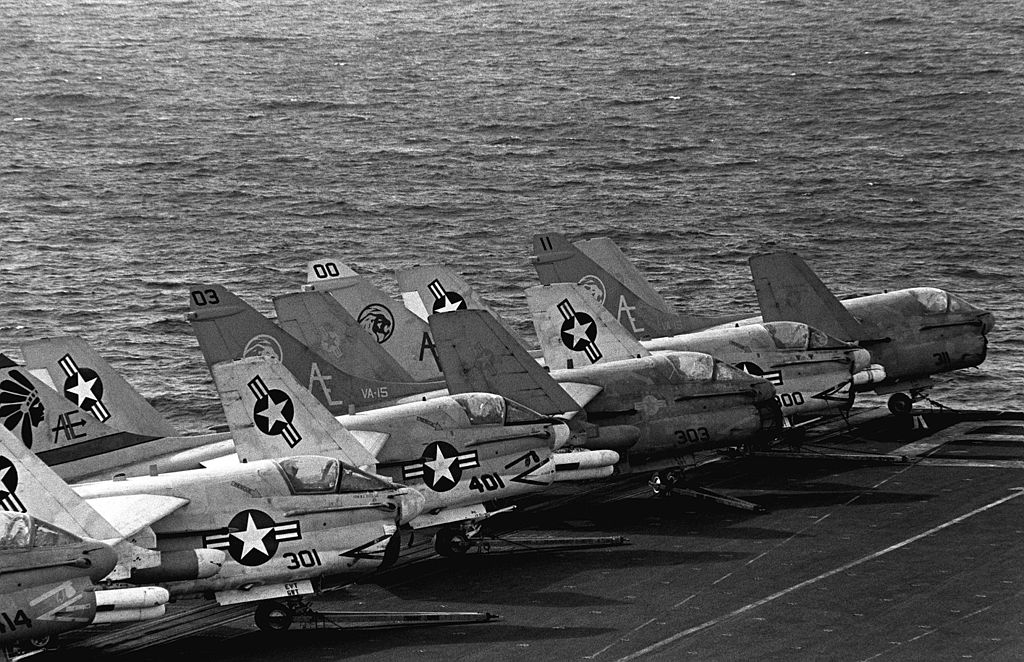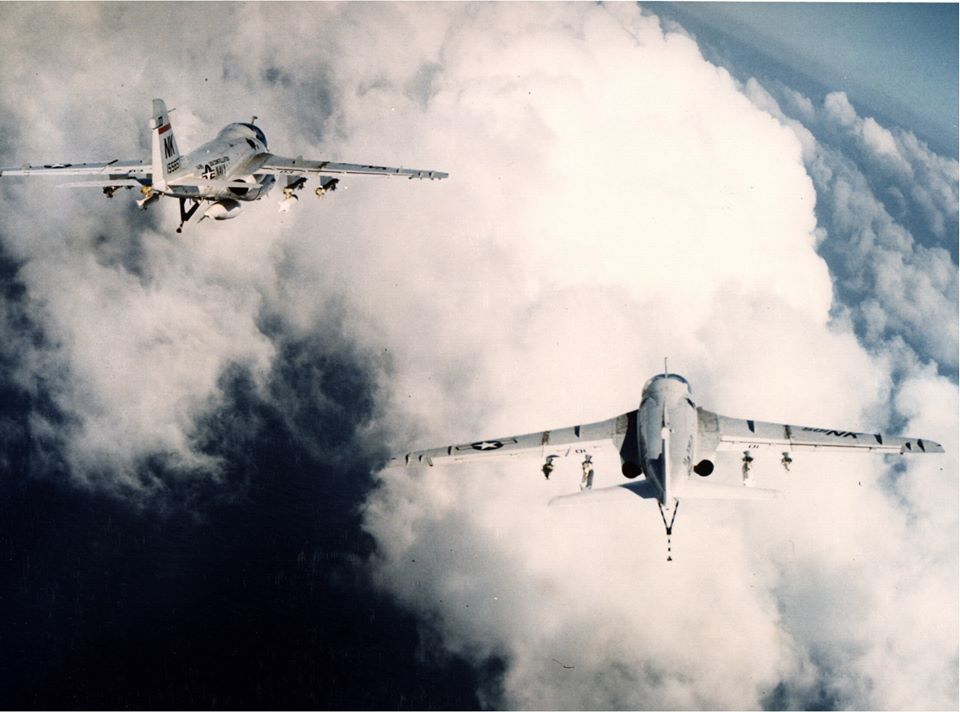Lt. Mark Adam Lange, a member of the A-6 crew, was injured during the ejection and passed away shortly after. After being handed over to Syrian forces, B/N Lt. Bobby Goodman spent many weeks in a detention facility close to Damascus
During the Vietnam War, the Grumman A-6 Intruder served as the “Main Battery” of carrier aviation. It was still in use by the US Navy and US Marine Corps in 1996. The A-6 was still the most potent strike aircraft on a carrier flight deck during the 1983 American attack on Lebanon because it was a true all-weather, day/night precision bomber.
The USS Independence (CV-62) continued after Operation Urgent Fury in Grenada in 1983 and eventually replaced USS Eisenhower (CVN-69), which was departing for home. These were still the days when the Sixth Fleet had two carriers assigned, and CV-62 joined USS John F. Kennedy (CV-67), which had CVW-3 — the first “dual A-6” air wing — onboard, as explained by Rick Morgan in his book A-6 Intruder Units 1974-96. Vice Adm. Jerry O. Tuttle, a renowned naval aviator with a background in light attacks, served as both the commander of Carrier Group Two and the commander of the Battle Fleet Sixth Fleet while serving as the senior officer on board CV-67.
The collapse of Lebanon, formerly known as “the Paris of the Middle East,” was at the forefront of world events at this time as many parties engaged in violence and disorder while citing various religious reasons. In order to help stabilize a fast destabilizing situation, the U.S. government sent Marines ashore in Beirut out of concern for a much larger battle involving Syria and Israel. To demonstrate the nation’s resolve, it also positioned two carriers offshore.
According to one of Turtle’s staff officers, Lt. Cdr. Joe Hulsey, ‘we had been on constant alert for weeks, with one carrier being in “alert 30” with aircraft fully loaded and crews briefed, while the other flight deck conducted normal flight ops. This changed every 24 hours in order to share the load. The force was ready, having prepared more than 300 potential targets in the region. We had timing and weapons loads planned for all of them, and all of this information was sent up the chain to Sixth Fleet and CINCEUR [Commander in Chief, US Forces Europe] so that they’d know what we were prepared to do. On top of that, we had Jerry Tuttle in charge. He was exactly who you’d want in that position if you were going over the beach.’
Up until around December 1, when the carriers got orders to stand down from constant alert, the hair-trigger state persisted. Then, at around 03:30 on the morning of the third, a Flash order from Sixth Fleet arrived with a four-hour time on target (ToT) for carrying out strikes against six particular targets in Lebanon. The staff initially thought the order had been sent inadvertently, but as voice and message traffic emerged between the ships and Sixth Fleet, it became clear that “somebody” much higher had ordered military action without giving a damn about what it would take for the operational forces to actually carry it out.
The right ordnance was not loaded, the crews were not briefed, and the aircraft were not ready or correctly spotted on the flight deck. Additionally, only one of the six designated targets had really been prepared by the ships, and the other five were brand-new and were thought to have no military significance. While the ships rapidly woke up, it was confirmed that the ToT was an absolute that had to be met, which led to an all-hands effort to carry out their orders.
What followed was a disaster.

Kennedy launched 12 Intruders, of which seven were from VA-85 and five were from VA-75. Independence also put five Intruders up in the air, along with several KA-6Ds (from VA-176). Along with the Tomcats and Prowlers from both carriers, the ‘Indy’ A-7Es also participated. Due to time constraints, ammunition loads were sometimes limited for their intended targets, Syrian tanks, and AAA sites in Lebanon’s Bekaa Valley, near the Syrian border. Only one Kennedy Intruder managed to escape with a full bomb load. At middle altitude at dawn, aircraft lost contact with the ground and were quickly surrounded by missiles and AAA. The sky was replete with infrared-guided weapons that were immune to the Prowlers’ magic, while EA-6Bs seemed to render any radar-guided SAMs useless.
Buckeye 556 (BuNo 152915), the only Intruder that was fully loaded, had to work hard to keep up with the rest of the formation. Both B/N Lt. Bobby Goodman and pilot Lt. Mark Adam Lange were present on board. As aircraft attempted to dodge the SAMs rising from the ground, the sky was flooded with flares and infrared decoys. A Syrian 9K31 Strela-1 or Strela-2 infrared-guided SAM shortly struck “Buckeye 556,” most likely. Lange soon passed away from wounds sustained during the crew’s ejection from the aircraft. Goodman was handed over to Syrian forces and subsequently jailed for several weeks not far from Damascus. After a flurry of diplomatic activity, including Reverend Jesse Jackson’s attendance, he would be freed.
The Intruders and Corsair IIs delivered weapons through the hail of fire, with VA-176 particularly dropping 25 Mk 82s, 23 Mk 83s, and 30 Rockeyes on its designated targets.
While flying VA-15 A-7E “Active Boy 305” (BuNo 157468), CAG-6 Cdr. Ed. Andrews assumed control of the search and rescue operation for the downed Intruder. He was shortly struck by an infrared-guided SAM himself and was forced to eject. He was later picked up by a helpful fisherman and transferred back to the U.S. Navy. A VA-15 Corsair II called “Active Boy 314” (BuNo 157458) was also struck, but its pilot was able to board Independence and make a full recovery.

As stated by Lt. Cdr. Hulsey, ‘even six more hours would’ve made all the difference in the world, but they wouldn’t give it to us. We found out later that the source (presumably out of Washington, D.C.) didn’t even get the time zone conversion right in the message, which cost us at least two more hours to prepare.’ As the saying goes, ‘Success has a thousand fathers while failure dies an orphan.’ In this case, it is still unclear who chose the target and ToT. Even though the bombing results were deemed “effective” in official reports, there was a rapid and long-lasting bitter taste of the strike on both ships and across carrier aviation. Professionally, the incident was regarded as nothing less than a failure. As a result, several modifications were made, including the establishment of “Strike U” at Fallon to create and disseminate more successful air wing tactics.
Photo by U.S. Navy
A-6 Intruder Units 1974-96 is published by Osprey Publishing and is available to order here.

